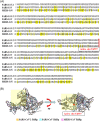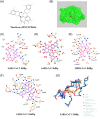The potential chemical structure of anti-SARS-CoV-2 RNA-dependent RNA polymerase
- PMID: 32167173
- PMCID: PMC7228302
- DOI: 10.1002/jmv.25761
The potential chemical structure of anti-SARS-CoV-2 RNA-dependent RNA polymerase
Erratum in
-
Corrigendum.J Med Virol. 2020 Oct;92(10):2248. doi: 10.1002/jmv.26176. Epub 2020 Jul 22. J Med Virol. 2020. PMID: 33411369 Free PMC article. No abstract available.
Abstract
An outbreak of coronavirus disease 2019 (COVID-19) occurred in Wuhan and it has rapidly spread to almost all parts of the world. For coronaviruses, RNA-dependent RNA polymerase (RdRp) is an important polymerase that catalyzes the replication of RNA from RNA template and is an attractive therapeutic target. In this study, we screened these chemical structures from traditional Chinese medicinal compounds proven to show antiviral activity in severe acute respiratory syndrome coronavirus (SARS-CoV) and the similar chemical structures through a molecular docking study to target RdRp of SARS-CoV-2, SARS-CoV, and Middle East respiratory syndrome coronavirus (MERS-CoV). We found that theaflavin has a lower idock score in the catalytic pocket of RdRp in SARS-CoV-2 (-9.11 kcal/mol), SARS-CoV (-8.03 kcal/mol), and MERS-CoV (-8.26 kcal/mol) from idock. To confirm the result, we discovered that theaflavin has lower binding energy of -8.8 kcal/mol when it docks in the catalytic pocket of SARS-CoV-2 RdRp by using the Blind Docking server. Regarding contact modes, hydrophobic interactions contribute significantly in binding and additional hydrogen bonds were found between theaflavin and RdRp. Moreover, one π-cation interaction was formed between theaflavin and Arg553 from the Blind Docking server. Our results suggest that theaflavin could be a potential SARS-CoV-2 RdRp inhibitor for further study.
Keywords: RNA-dependent RNA polymerase; SARS-CoV-2; theaflavin; traditional Chinese medicinal compounds.
© 2020 Wiley Periodicals, Inc.
Conflict of interest statement
The authors declare that there are no conflict of interests.
Figures


References
Publication types
MeSH terms
Substances
Grants and funding
LinkOut - more resources
Full Text Sources
Other Literature Sources
Medical
Research Materials
Miscellaneous

